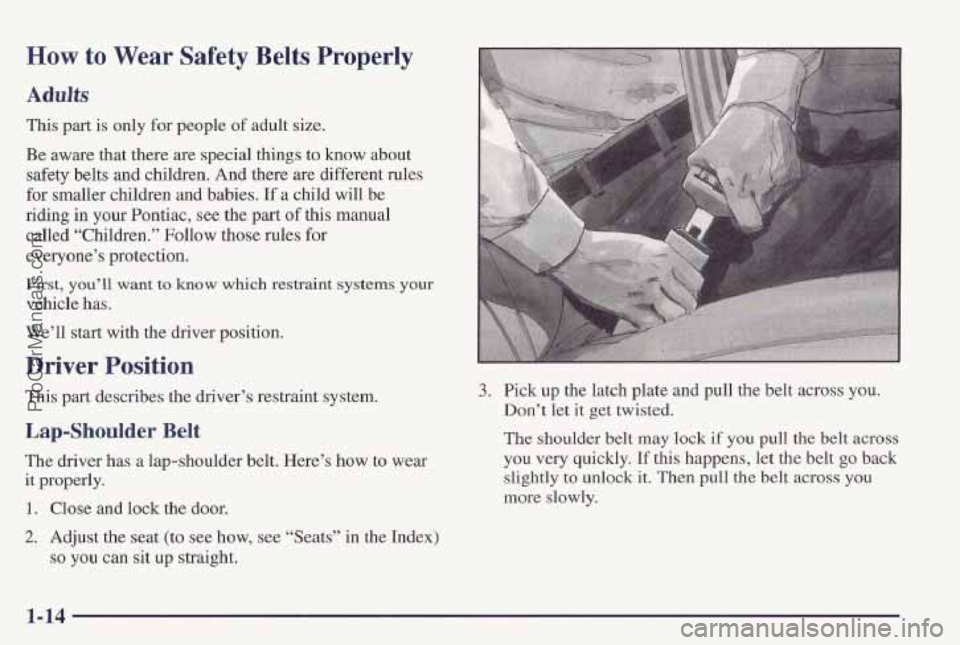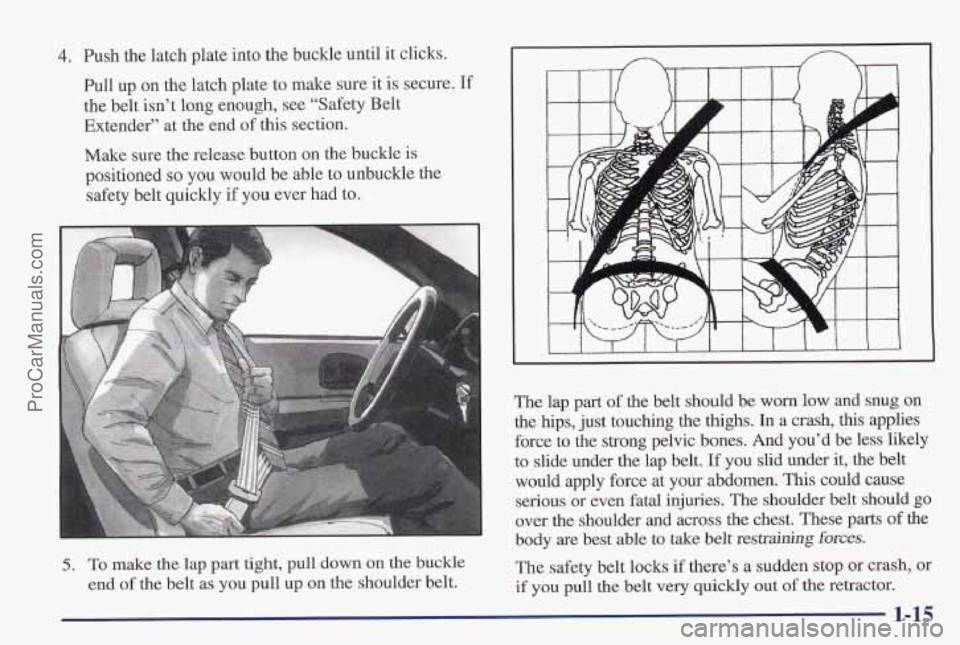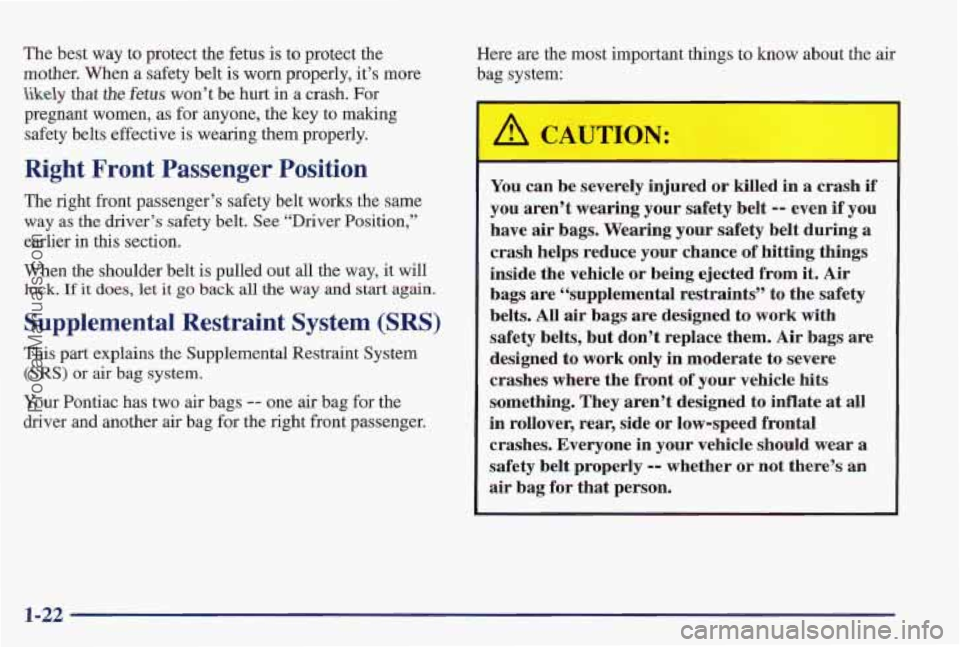Page 7 of 419
Vehicle Symbols
These are some of the symbols you may find on your vehicle.
For example,
these symbols are used on an
original battery:
POSSIBLE A
CAUTION
INJURY
PROTECT EYES BY
SHIELDING
CAUSTIC
BURNS AVOID
SPARKS
OR
FLAMES
SPARK OR ,\[I,
COULD FLAME
EXPLODE BATTERY
These symbols are important
for you and
your passengers
whenever your
vehicle is
driven:
n
FASTEN
SEAT
BELTS
q4
AIR BAG p
These symbols
have to do with
your lamps:
SIGNALS e
TURN
PARKING LAMPS
FOG LAMPS
$0
These symbols
are
on some of
your controls:
WINDSHIELD
WIPER
WINDSHIELD DEFROSTER
WINDOW
DEFOGGER
VENTILATING
~3
FAN
These symbols are used
on
warning and indicator lights:
COOLANT -
TEMP -
CHARGING BATTERY
SYSTEM
BRAKE
(0)
h
COOLANT
ENGINE OIL
w,
PRESSURE
ANTI-LOCK
(@)
BRAKES
Here are some
other symbols
you may see:
FUSE
P
LIGHTER m
HORN )cr
SPEAKER
b
FUEL la
V
ProCarManuals.com
Page 12 of 419
2-Way Manual Lumbar (If Equipped) 4-Way Power Lumbar Driver’s Seat
(If Equipped)
The knob that controls this feature is located on the right
side
of the driver’s seat, about half of the way down the
seatback. Turn the knob clockwise to increase lumbar
support.
Turn the knob counterclockwise to decrease
lumbar support.
If you have this option, there will be a toggle switch on
the left side of the driver’s seat cushion, just in front of
the reclining seatback lever. To increase or decrease
lumbar support, push the switch forward or rearward,
To adjust the lumbar support up or down, push the
switch
up or down.
1-4
ProCarManuals.com
Page 13 of 419
Heated Seat (If Equipped)
If your vehicle has this
option, the switch
is on the
center console, just behind
the open storage bin,
Press LO to warm the seat to a lower temperature. Press
HI to warm the seat to a higher temperature. To turn this
feature
off, place the switch in the center position.
Reclining Front Seatbacks
Lift the lever to release the seatback, then move the
seatback to where you want
it. Release the lever to
lock the seatback in place. Pull up on the lever
without pushing on the seatback, and the seatback
will move forward.
ProCarManuals.com
Page 15 of 419
Head Restraints
Slide the head restraint up or down so that the top of the
restraint is closest to the top
of your ears. This position
reduces the chance of a neck injury in a crash.
Seatback Latches (2-Door Models)
After someone gets into the rear seat area, move the
right front seatback to its original position. Then move
the seat rearward until it locks.
To get out, tilt the seatback fully forward.
On two-door models, the right front seat
is designed to
make it easy to get in and out
of the rear seat. Tilt the right
seatback fully forward, the whole seat will now slide
forward.
If the seat will not tilt, lift the seatback latch,
located on
the back of the seat, to tilt the seatback forward.
If the seatback isn’t locked, it could move forward
in a sudden stop or crash. That could cause injury
to the person sitting there. Always press rearward
on the seatback to be sure it is locked.
I
1-7
ProCarManuals.com
Page 22 of 419

How to Wear Safety Belts Properly
Adults
This part is only for people of adult size.
Be aware that there
are special things to know about
safety belts and children. And there are different rules
for smaller children and babies. If a child will be
riding in your Pontiae, see the part of this manual
called “Children.” Follow those rules
for
everyone’s protection.
First, you’ll want to know which restraint systems your
vehicle has.
We’ll start with the driver position.
Driver Position
This part describes the driver’s restraint system.
Lap-Shoulder Belt
The driver has a lap-shoulder belt. Here’s how to wear
it properly.
I. Close and lock the door.
2. Adjust the seat (to see how, see “Seats” in the Index)
so you can sit up straight.
3. Pick up the latch plate and pull the belt across you.
Don’t let it get twisted.
The shoulder belt may
lock if you pull the belt across
you very quickly. If this happens, let the belt
go back
slightly
to unlock it. Then pull the belt across you
more slowly.
1-14
ProCarManuals.com
Page 23 of 419

4. Push the latch plate into the buckle until it clicks.
Pull up on the latch plate to make sure it is secure.
If
the belt isn’t long enough, see “Safety Belt
Extender” at the end
of this section.
Make sure the release button on the buckle is
positioned
so you would be able to unbuckle the
safety belt quickly if you ever had to.
-4
5. To make the lap part tight, pull down on the buckle
end
of the belt as you pull up on the shoulder belt. The
lap part
of the belt should be worn low and snug on
the hips, just touching the thighs. In a crash, this applies
force to the strong pelvic bones. And you’d be less likely
to slide under
the lap belt. If you slid under it, the belt
would apply force at your abdomen. This could cause
serious
or even fatal injuries. The shoulder belt should go
over the shoulder and across the chest. These parts of the
body are best able to take belt restraining
foxes.
The safety belt locks if there’s a sudden stop or crash, or
if you pull the belt very quickly out of the retractor.
1-15
ProCarManuals.com
Page 24 of 419
Shoulder Belt Height Adjuster (4-DOOr Models)
Before you begin to drive, move the shoulder belt
adjuster
to the height that is right for you.
To move it down, squeeze the release lever and move
the height adjuster to the desired position. You can move
the adjuster up just by pushing
up on the shoulder belt
guide. After you move the adjuster to where you want it,
try to move it down without squeezing the release lever
to
make sure it has locked into position.
Adjust the height
so that the shoulder portion of the
belt is centered
on your shoulder, The belt should be
away from your face and neck, but not falling
off
your shoulder.
1-16
ProCarManuals.com
Page 30 of 419

The best way to protect the fetus is to protect the
mother. When
a safety belt is worn properly, it’s more
likely khat the fetus won’t be hurt in a crash. For
pregnant women, as for anyone, the key to making
safety belts effective is wearing them properly.
Right Front Passenger Position
The right front passenger’s safety belt works the sarne
way a,s the driver’s safety belt. See “Driver Position,”
earlies in this section.
When the shoulder belt is pulled out all the way,
it will
lock.
If it does, let it go back all the way and start again.
supplemental Restraint System (SRS)
This part explains the Supplemental Restraint System
(SRS) or air bag system.
Your Pontiac has two air bags -- one air bag for the
driver and another air bag for the right front passenger. Here are the most important things
to know about the
air
bag system:
A CAUTION:
You can be s’everely injured or killed in a crash if
you aren’t wearing your safety belt -- even if you
have
air bags. Wearing your safety belt during a
crash helps reduce your chance of hitting things
inside the vehicle or being ejected from
it. Air
bags are “supplemental restraints” to the safety
belts. All
air bags are designed to work with
safety belts, but don’t replace them. Air bags are
1 designed to work only in moderate to severe
crashes where the front
of your vehicle hits
something. They aren’t designed to inflate at all
in rollover,
rear, side or low-speed frontal
crashes. Everyone in your vehicle should wear
a
safety belt properly -- whether or not there’s an
air bag for that person.
1-22
ProCarManuals.com